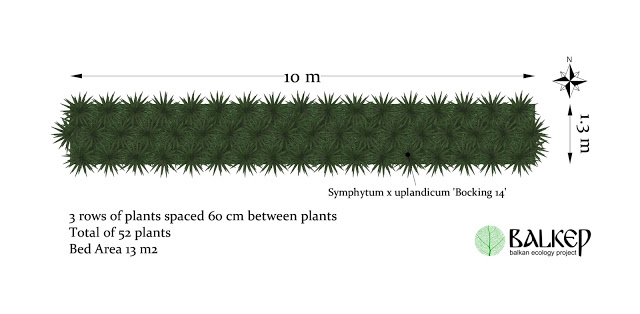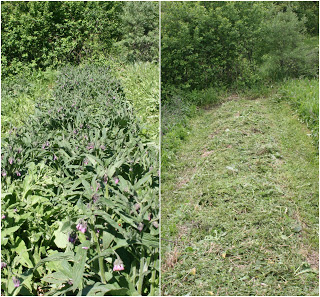Inspired by the work of Lawrence D Hills (1911–1991) who undertook extensive research on comfrey during his lifetime, we decided to start some comfrey trials of our own to see just how much biomass these plants can produce for us, how well they fertilise our crops, how attractive they are for garden wildlife and whether they have a beneficial impact on the soil.
We sought to do this by planting out a test bed and measuring the weight of each cut we took. The biomass was then processed to make a liquid concentrate that was applied to our market garden crops. During the season we casually observed invertebrate activity in the patch and also during cutting times and finally each year after the cuts are complete we send a soil sample from the patch off to the lab for analysis of pH N,P and K to compare with a base sample taken before we established the patch.
We also record all inputs of mulch, ash, compost and water applied to the bed.
If you would like to learn more about comfrey and why it's considered such a great plant by many people take a look at our previous post Comfrey - BELIEVE the HYPE!. To find out the results from this year's trials read on.
Comfrey Patch Overview

The comfrey beds are located in the red box in the above image of our Polyculture Market Garden in Shipka, Bulgaria
Location - Our Market Garden, Shipka, Bulgaria
Climate: Continental Temperate
Latitude: 42°
Elevation: 565 m
Average Annual Rainfall: 588.5 mm
Co-ordinates: 42.71259, 25.32575
Species/Cultivar - Symphytum x uplandicum 'Bocking 14'
Test Bed Area - 13 m2
Bed Dimensions - 10 m x 1.3 m
Total Plants - 42
Approx. planting spacing - 60-70 cm

Graphical Representation of the Comfrey Trial Patch
Background
The patch was prepared in the spring of 2015. Two 13m2 beds were allocated to the comfrey but only 1 bed was used to take records. For instructions how to set up a comfrey patch see our previous article here
Following taking a soil sample from the area we dug over the plot, removing weeds and added 20 L of mature compost per m length of bed (200L) and 70g of wood ash per m length (700g). We planted out the beds using divided crowns of larger plants and left them to grow without disturbance for the entire season. We also broadcast approx. 1.5 g per m2 of Trifolium repens onto the pathways between the beds.
Planting Material - It's easy to plant out with crown divisions or root cuttings in the spring when the soil has warmed. A crown division can be obtained from simply putting a spade through the center of a mature comfrey plant and transplanting the divided sections. For our patch I divided 2 yr old plants into quarters, sometimes sixths, and these established very well in the first year. We did not harvest the leaf biomass in the first year in order to allow a deep root system to develop. However if you use large divisions you can start harvesting in July.
Plants in the 2nd month after planting in 2015
We took a soil sample in the area before preparing the beds in March 2015 the results of which you can find below and a further sample in November of 2016 . Both samples were sent to NAAS of the Ministry of Agriculture and Food. It's interesting to see general improvements in the bed soil fertility despite the removal of the biomass from the bed.


Soil Analysis Results from March 2015
Soil Analysis Results from November 2016
Management
Irrigating - Irrigation was applied to the beds every 10-14 days without rain which this season was from mid June - mid October - almost 15 weeks without a significant rainfall. We use flood irrigation diverted into the paths from mountain stream. I'd estimate 30 L per m length each week without rainfall would be sufficient.
Kata and Ute cutting the patch
Cutting - We cut the Comfrey four times this season (see below for dates and weights). The comfrey is cut to approx 5 cm from the ground using a sickle, shaken out so all of the wildlife drops out and weighed immediately.
Kata, Natasha and Ute cutting and weighing
Mowing - After the cut the pathways and surrounding paths are mown and the trimmngs are applied more or less evenly to the surface of the bed.
Preparing Liquid Fert - The fresh material is stuffed into a 200 L barrel with stones on the top to compress the material and left to decompose for a few weeks. The result is a black smelly slurry that can be sieved off to leave a quantity of dark brown liquid. The liquid can then be diluted from 1-15 to 1-20 and applied to crops. The largest cut we made from 13m2 bed just about fit into the 200 L barrel.

Comfrey Patch - before and after cut and path mowing
Regrowth 23 days after the first cut
We left the plants to flower for 7 -10 days before each cut, seeing as the bees were so into the flowers. This probably resulted in lower yields and next year we intend to cut before flowering and plant extra plants nearby solely for the bees and other pollinating insects
Comfrey 'Becking 14' before the first cut in April
Results
From the 13 m2 patch we harvested a total of 96.92 kg of comfrey leaves. This was obtained from four cuts.
click here to see the table: http://balkanecologyproject.blogspot.bg/2016/11/how-much-comfrey-can-you-grow-on-13m2.html
Fertility Inputs
Following the initial input of 20 L of mature compost per m length of bed (200L) and 70g of wood ash per m length (700g) when we estbablished the bed in the spring of 2015, during 2016 the only fertility inputs were the trimmings from the pathways between and around the beds. We mowed this section four times (after each cut ) and each time emptied approx four 30 L mower bags of trimmings onto the comfrey bed totaling 480 L of trimmings.
Considerations
For higher yields the plants should be cut before flowering. We did not carry out this practice as the bees found the flowers so attractive.
I believe we could also increase yields by applying urine fertiliser and we will experiment with this in the future. This would be particularly useful if growing the comfrey for animal fodder or mulch for perennial plants.
Carpenter Bees one of many species of solitary bees that feed from the Comfrey flowers as well as Honey bees.
We used most of the comfrey for making a liquid fertilsier for our market garden crops. We produced 47 L of concentrate that can be mixed 1-15 with water . We applied the dilute at a rate of 500ml per plant to tomato plants when setting fruit. The last batch we used for mulch and covered an area of 4 m2 with approx 11.5 kg of material. Comfrey can also be used to feed animals. Our rabbits and pigs both enjoy the fresh material and we use plants growing in our garden around the animal housing for this.
Our pigs enjoying the Comfrey leaves
Joining the Trials
If you would like to join the comfrey trials fill in your details below and we'll email you our record keeping templates. It will be great to have records from all over the world and see how well these plants grow in different climates.
Hi! I am a robot. I just upvoted you! I found similar content that readers might be interested in:
http://balkanecologyproject.blogspot.ca/2016/11/how-much-comfrey-can-you-grow-on-13m2.html
Downvoting a post can decrease pending rewards and make it less visible. Common reasons:
Submit